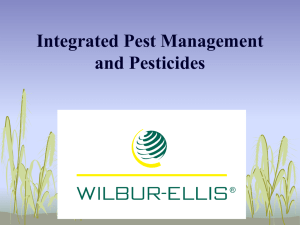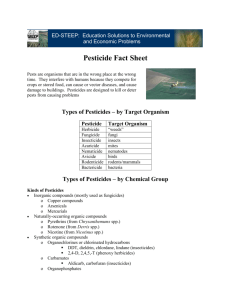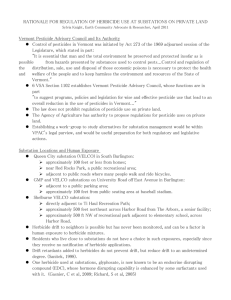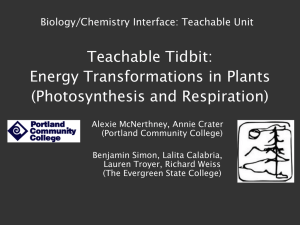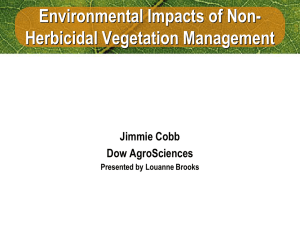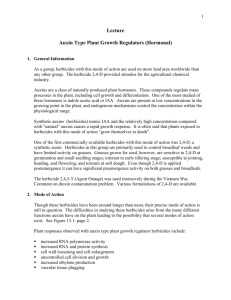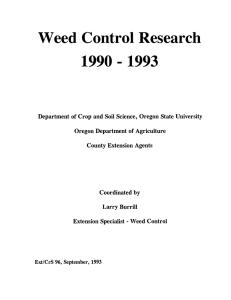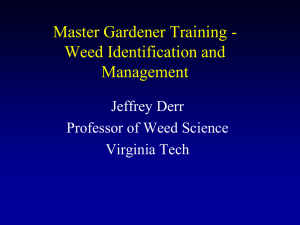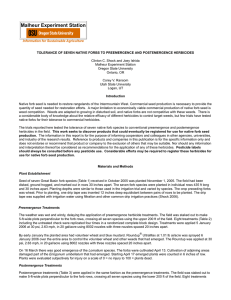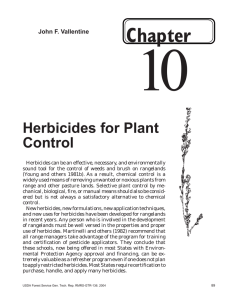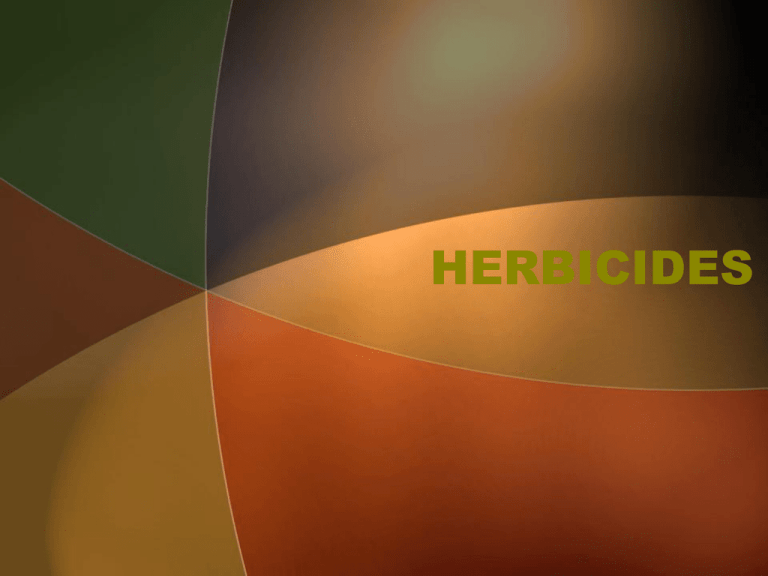
HERBICIDES
BIOLOGICAL
• Few with practical application
• Xpo (Xanthomonas bacteria) for
Annual bluegrass control
SYNTHETIC
AMINE AND ESTER FORMULATIONS
• Adding side group molecules to active
ingredient
– Amine: Dimethylamine group to an acid
– Ester: isooctyl group to an acid
SYNTHETIC
Amine formulation
• Less volatile and less non-target
effects
SYNTHETIC
Ester formulation
• Penetrates leaf easier
• More volatile (vapor
drift)
• Winter and early
spring: cooler temps
and less leaves
SYNTHETIC
ISOMERS
• Different versions of same
chemical
– Left hand versus right hand
SYNTHETIC
ISOMERS
• One very effective, the
other not at all
• Isolate effective isomer,
get rid of ineffective one
– Lower rates, same result
(Acclaim Extra)
SYNTHETIC
SURFACTANTS
• Formulation surfactants included with
product
• Roundup Pro increased absorption and
rainfastness
FORMULATION
Granular
• Less volatile
• Won’t stick to leaves
• Less phytotoxic effects
• Cost more: mostly inert ingredients,
shipping costs
• Public acceptance
• Less staining and easier clean up
FORMULATION
Liquid
• More volatile, better post- effect
• Phytotoxic to non-target
• Cheap
• Bad image
PREEMERGENT
Applied before seed germination
– Kills the weed seed as it germinates
• Timing is critical, will not control
established weeds
• Aeration does not effect control
• A few herbicides have pre and post activity
– Dimension
• Most often a granular that requires water-in
POSTEMERGENCE
• Applied after weeds have emerged
POSTEMERGENCE
HERBICIDE UPTAKE
Soil-applied
• Absorbed by germinating roots
– Some shoots
POSTEMERGENCE
HERBICIDE UPTAKE
Foliar-applied
• Cuticle, the waxy surface of the leaf
• Leaf hair
POSTEMERGENCE
FACTORS AFFECTING MOVEMENT INTO
LEAF
Foliar retention
• Water carrier
– Surface tension of water
– Reduced leaf contact
POSTEMERGENCE
FACTORS AFFECTING MOVEMENT INTO LEAF
Foliar retention
• Spray volume
– Complete coverage for contact
– Partial coverage for systemic
POSTEMERGENCE
FACTORS AFFECTING MOVEMENT INTO
LEAF
Foliar retention
• Rainfall
• 6 to 24 hours
POSTEMERGENCE
Systemic herbicides
• Move with plant food
• Kill all parts of the plant
• Rapid growth favorable for kill
POSTEMERGENCE
Contact herbicides
• Kill tissue applied, no distribution
throughout plant
• Membrane destruction in hours
• Control of annuals
• Perennials require repeat application
• FAST
MODE OF ACTION
SELECTIVE HERBICIDES
SEDGE CONTROL
• Manage
• Image
• Certainty
• Monument
MODE OF ACTION
GRASS CONTROL
• Vantage controls bahiagrass
• MSMA controls crabgrass
MODE OF ACTION
BROADLEAF CONTROL
PHENOXY HERBICIDES (after WWII)
• 2,4-D, good on dandelion
– Many turfgrasses sensitive
• MCPP (Mecoprop), good on clover
MODE OF ACTION
BROADLEAF
CONTROL
PHENOXY HERBICIDES
(after WWII)
• Trimec
• Bentgrass Selective
MODE OF ACTION
BROADLEAF CONTROL
BENZOIC ACID
• Dicamba
MODE OF ACTION
Sulfonylurea family
• Manor and Blade on broadleaf and
grassy
• Certainty, Sedgehammer and
Monument control of sedge, kyllinga
and poa
MODE OF ACTION
Pyridine family
• Could replace 2,4-D
• Turflon, Spotlight and Lontrel
– 10 times more potent than 2,4-D
• Confront found in compost clippings,
limited to commercial use
MODE OF ACTION
Triazolinone family
• Quicksilver (Carfentrazone)
• Speed Zone
– 2,4-D, MCPP, Dicamba, and
Carfentrazone
MODE OF ACTION
Quinolinecarboxylic acid family
• Drive for post crabgrass control
MODE OF ACTION
Triazine family
• Atrazine soluble, non-target damage
• Research change frog sex and lending
to death
– Centipede
– St. Augustine
MODE OF ACTION
NON-SELECTIVE HERBICIDES
• Kills most plants
– Glyphosate is systemic (slow)
– Diquat is contact (fast)
• QuikPro (Round-up) combines for
quick, systemic kill
– Limits systemic effect
MODE OF ACTION
Fumigation
• Kills plants, MO, seeds, etc.
• Methyl Bromide
– Odorless
– Teargas added
MODE OF ACTION
Fumigation
• Plastic cover to prevent leakage
– 24 to 48 hours
MODE OF ACTION
Fumigation
• Methyl Bromide phasout due to
ozone-depleting potential
• Dazomet is unclassified granular
fumigant
MOSS
• Low nitrogen and wet areas
• Copper containing fungicides, soapy
solutions
GENETICALLY MODIFIED
TURF (GMO)
• Genes isolated from other plants,
animals or microbes for herbicide
and insect resistance
• Round-up Ready corn and soybeans
• http://grist.org/industrialagriculture/a-growing-problemnotes-from-the-superweed-summit/
PLANT GROWTH REGULATOR
•
•
•
•
Inhibit growth
Suppress seedheads
Reduce costs and maintenance
Enhance turf quality
– possibly increase roots
– improve shade tolerance
– improve roll
PLANT GROWTH REGULATOR
CELL-DIVISION INHIBITORS, TYPE 1
• Vegetative growth
• Seedhead development
PLANT GROWTH REGULATOR
CELL-DIVISION INHIBITORS, TYPE 1
• Growth inhibition for 3 to 4 weeks
• Yellowing
• Embark
PLANT GROWTH REGULATOR
GIBBERELLIN INHIBITORS, TYPE 2
• Suppress cell elongation, internodes
shorter
• 3 to 6 weeks
• Cutless
ORGANIC HERBICIDES
SOAPS
• Fatty acids
• Stripping cuticle
– Dehydrate
• Safer and M-pede
ORGANIC HERBICIDES
ESSENTIAL OILS
• Clove and cinnamon oil
– Eugenol
• Disrupting cell membranes
• Matran and EcoExempt
ORGANIC HERBICIDES
ESSENTIAL OILS
• Citrus oil
– Limonene
– hand cleaner and degreaser
• Nature’s Avenger
ORGANIC HERBICIDES
VINEGAR
• Acetic acid
– Not household vinegar
– >20%
• Not listed it as an herbicide
• Avoid EPA registration
• AllDown and Burnout II
ORGANIC HERBICIDES
PELARGONIC ACID
• fatty acid
• synthetically produced
– not organic
• Scythe
ORGANIC HERBICIDES
CORN GLUTEN
• Applied 4 to 6 weeks before target
dates
• Contains 10% nitrogen
• First year, expect 50% weed control
• Second or third year 90%

